#also a bonus that the iguanas come in fun colors!
Explore tagged Tumblr posts
Text
To celebrate me starting the last chapter of the main part of the first book of my Owl House HP AU here are some sketches of some of the kiddos!
I might put colored versions of these drawings into the final draft.
(Fair warning, I do not claim to be an artist. Headshots are about the extent of my abilities.)
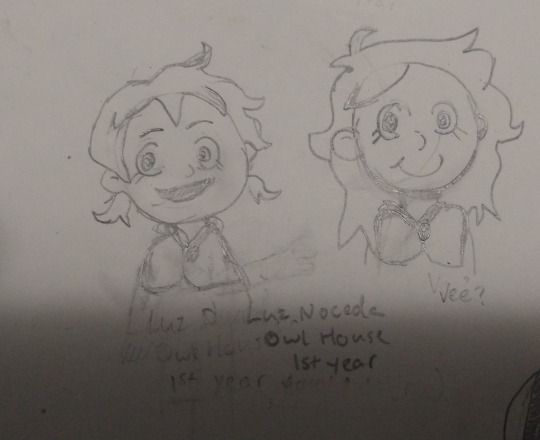
First up, our protaganist, 11-year-old Luz Noceda! She wears her hair in pigtails most of the time. The image on the right is a possible design of her with her hair down. (or a possible Vee, whose design I haven't fully pinned down yet) And I realized I forgot her scar whoops She's also supposed to have a scar across her left eyebrow which I forgot to draw but please imagine it's there.
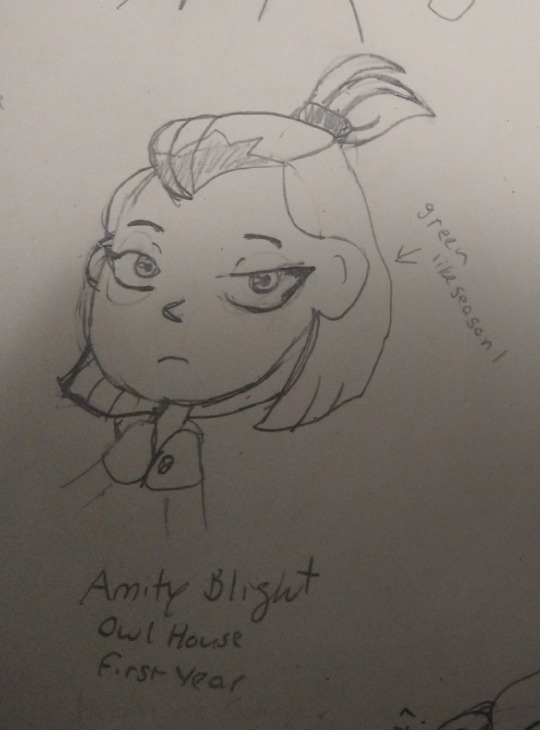
Next up, 11-year old Amity Blight! Her little ponytail was an absolute pain to figure out how to draw. I think I managed it passably though. Her hair is dyed green, like it was in season 1 of the show.
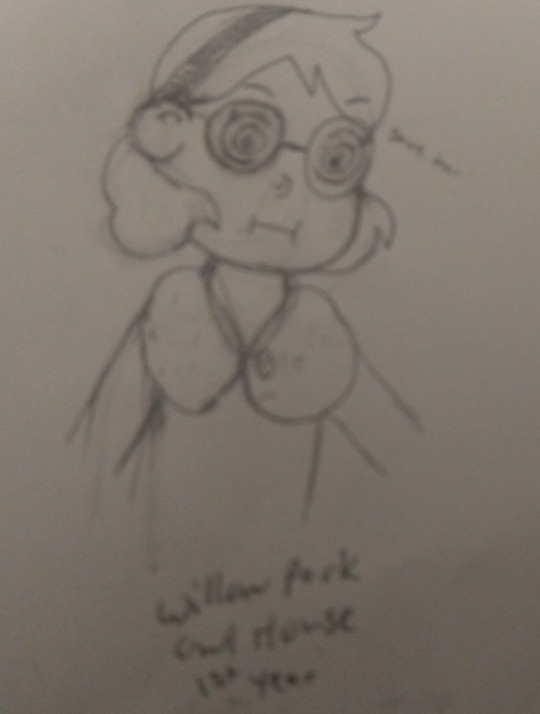
12-year old Willow Park! Poor girl, she is haunted. Sorry, eyes are still a weakness. She's a year older than the others but still in the same grade because her birthday is after the first day of school. For Willow, this adds to her feeling of being behind everyone else.

9-year old Gus Porter! I should mention that the witches in this AU have normal round human ears, just like the wizards in the Harry Potter books. I imagine little Gus to have quite large ears that he will grow into some later. Again I apologize for the eyes.
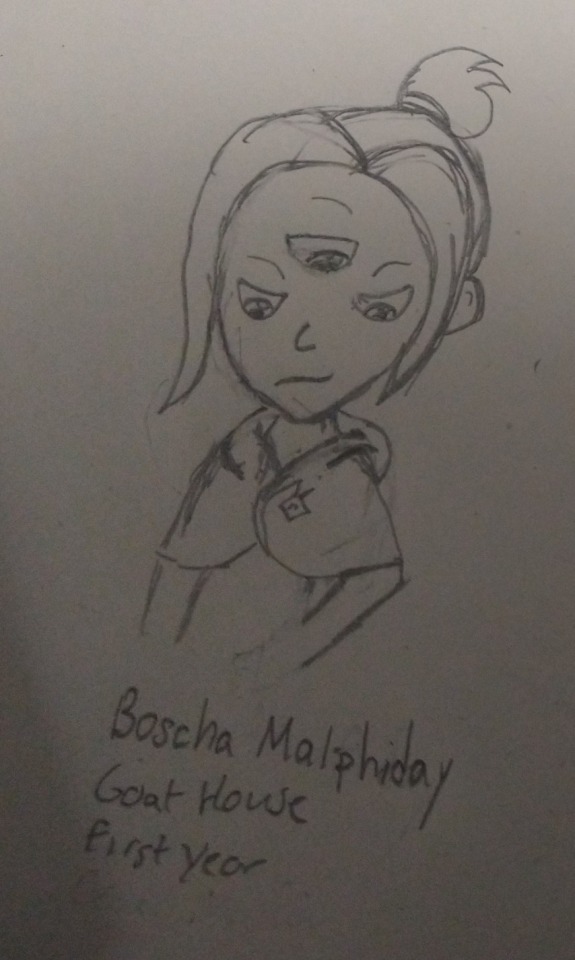
11-year old Boscha Malphiday! I'm really pleased with how she turned out, although I struggled with her third eye and I'm still not 100% satisfied with how it turned out. Her surname in this AU is a play off of Malfoy--Malfoy comes from the French for "bad faith" (mal foi); Malphiday comes from "mal fidei", Latin for "bad faith".
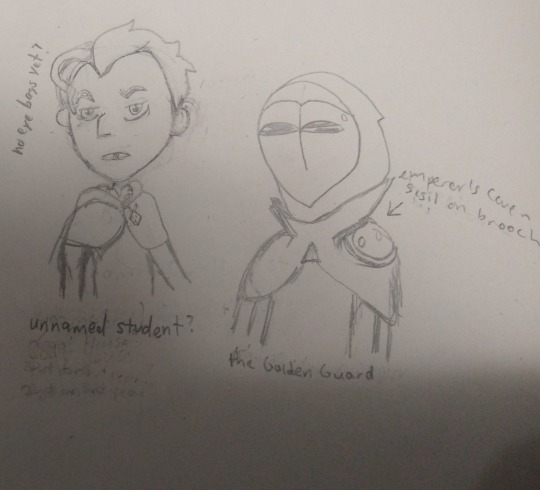
13-year-old Hunter! He only appears as a cameo in the main storyline of Book 1, but he has a big part in one of the bonus epilogue chapters (which I haven't really written yet). In this timeline, he has only recently officially received his Golden Guard title. He hasn't gotten his cheek scar, ear notch, or eye bags yet (they will all come in due time) but he does have his tooth gap. He got that from getting his face punched in during training. I drew his Golden Guard uniform with only the one pauldron on his left shoulder as in the show, but I'm thinking of giving him a second one on his right shoulder like in the storyboards.
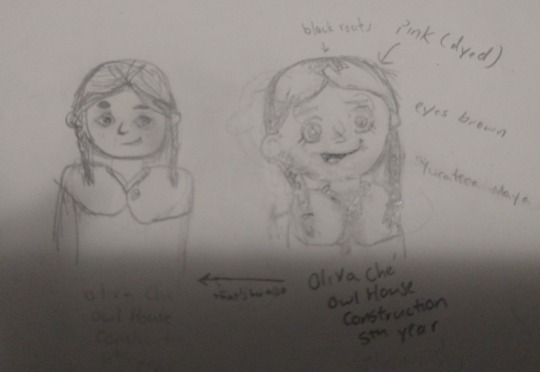
Meet 15-year-old Oliva Che'! She's one of my OCs. She's basically the Oliver Wood character--the captain of the Owl House grudgby team. She is a very spirited and gung-ho type and very enthusiastic about grudgby. She is in the construction track, although she is not a huge fan of the coven system. She's kind of a fun big sister to the younger Owl House students. She is of Yucateca Maya descent. She has brown or gold eyes. Her hair is naturally black but she dyes it a different color every year and usually keeps it in braids. This year it's pink. Unfortunately Paint did a weird thing when I cropped this picture and made her blurry I am so angry Her Palisman (not pictured) is a black spiny-tailed iguana named Toloc.

Meet 16-year-old Saka Katu! She is another OC. She is a cat demon girl and Oliva's girlfriend and also plays on the Owl House grudgby team (mostly because Oliva insists). She is in Potions track and believes deeply in the Coven system. She's a little uptight, some might call her bossy, and big into following the rules. She's kinda of a strict big sister type to the younger Owl House students. She keeps Oliva from being too reckless while Oliva keeps her from being too stiff. Saka is Malagasy for cat and Katu is Basque for cat so her name is literally "cat cat". She may or may not have a Palisman; if she does, it's some sort of fish.
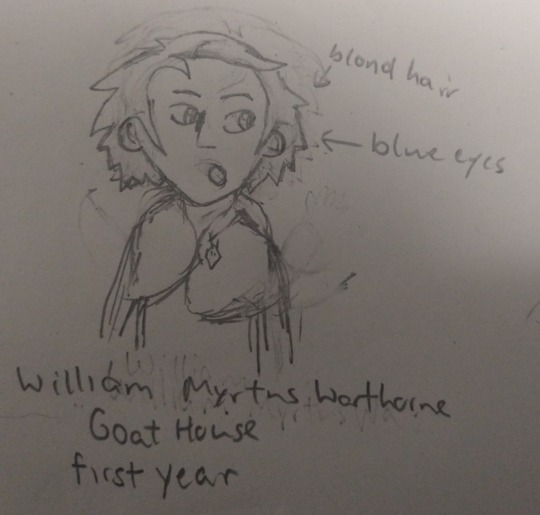
Last but not least, 11-year-old William Myrtus Warthorne! His design is based off of Ser William from the audio tests/pilot. He is described as a handsome boy--broad-shouldered, with blond hair and blue eyes and a hooked nose which I swear I fixed but somehow it's still wrong ORZ. He is in Goat House and is friends with Boscha, but he doesn't participate in bullying (he doesn't do anything to stop it, though, he's just sort of there). He has a friendly, laidback personality and can get along with just about anyone. It's not discussed in this book (it's more of a plot point in book 2), but his family, the Warthornes, are a cadet branch of the Clawthornes which is why he has Clawthorne and Wittebane features.
2 notes
·
View notes
Text
Did you know Godzilla was (likely) based off a marine iguana, has a subspecies of marine iguana named after him, and is my current hyperfixation?
anyways, making my own AU where all of my Godzilla favorites (as i watch the older movies) are more closely representative of their base species. already decided on Mothra being an atlas moth, Godzilla being a Amblyrhynchus cristatus godzilla (the Godzilla marine iguana), Ghidorah as a pit viper, Behemoth as an African elephant/mammoth (see Rodan's explanation), Kong as a silverback gorilla, Mutos as praying mantises/black widows (depending) and Rodan as a quetzalcoatlus/vulture (depending on if i decide to use extinct species or not)
#orca shut up#orca.godzilla#my au#au planning#gonna call it something along the lines of Origin AU#based on the origins of the characters#also a bonus that the iguanas come in fun colors!#he will be colorful!
0 notes
Text
My ATLA animal combos! (Pt. 1)
1.) Humming-toads
[hummingbird + toad]
“Far off, a flock of humming-toads flitted from pagoda to pagoda. Their calls echoed throughout the temple—warbling, high-pitched croaks.“
Think of a fat, bulbous little toad flitting about on blurred wings. That’s a humming-toad! These creatures populate the Western Air Temple and surrounding terrain. Their bodies tend to be a mix of dull browns and greens, but their wings are all the colors between magenta and orange. They feed mostly on nectar, using their long tongues to reach into flowers. They also catch insects.
Fun Fact: Zuko was going to practice his speech on one of these, but they never sat still long enough for him to get past “Hello, Zuko here.”
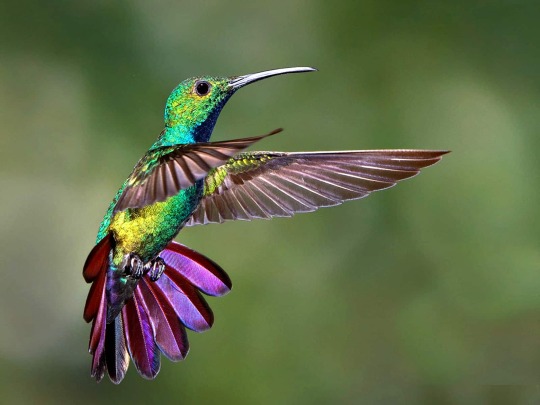
+

2.) Panther-bats
[panther + bat]
“The pagodas hung from the cliffside like so many panther-bats, awaiting moonrise.“
Panther-bats are sleek, deadly predators that take to the skies at night. They have two methods of hunting: echolocation for the sky and stalking for the ground. Their prey ranges from cicada-keets to honey-iguanas. They live in the jungle around the Sun Temple and the mid-islands of the Fire Nation. They have been known to stalk toddlers at dusk, so keep your kids inside when the sun begins to dip beneath the horizon.
Fun fact: panther-bats used to be the primary prey of dragons; currently, the Sun Warriors hold a hunt every eight years to control the panther-bat population.
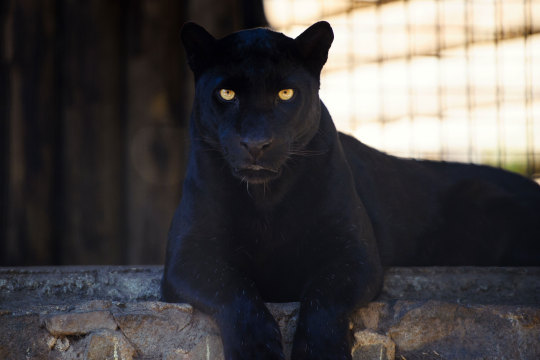
+

3.) Honey-iguanas
[bee + igauna]
“’I’m a vegetarian,’” Aang said quickly, “’but I’m sure Zuko here would love to try a bite.’”
Zuko shot Aang a glare, but he tugged the plate towards himself. The meat was blackened in some areas, and it shone with a thick, golden substance.”
These iguanas are a brilliant, yellow-gold with green-ish spines running along their backs. They can be found building hives of four iguanas each throughout the jungle. The Sun Warriors use honey-iguanas for meat; when roasted, the meat is juicy and sweet. Beware of their spines--each holds a stinger.
Fun fact: when harvested in large amounts, honey-iguana venom can make for a very mild entheogen.

+
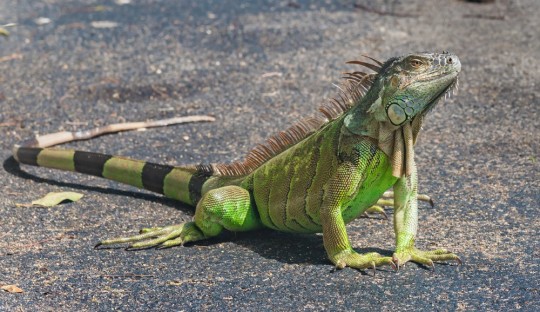
4.) Flamingo-ticks [Flamingo + tick]
“I was just checking Appa for flamingo-ticks. He doesn’t have any. Flamingo-ticks, I mean.”
Flamingo-ticks are external parasites that primarily feed on Flying Bison--though they’ve moved on to smaller prey in the past century or so. Found at the base of all four air temples, these little buggers are easy to spot but hard to remove. Look for a small dot of bright pink among your bison’s fur, but beware of their curved beak, lodged underneath your bison’s skin.
Fun fact: if you dot a flaming-tick’s back with oil from a poppy-fern, they’ll fall asleep and dislodge themselves.
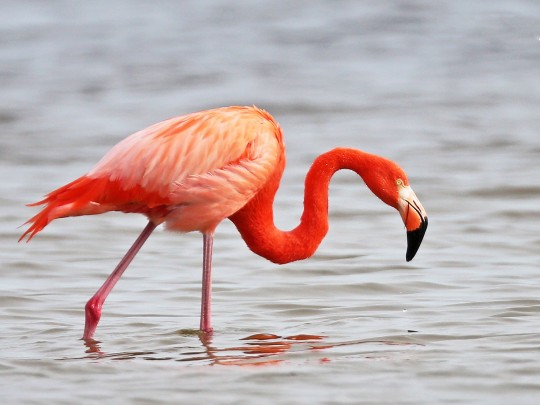
+
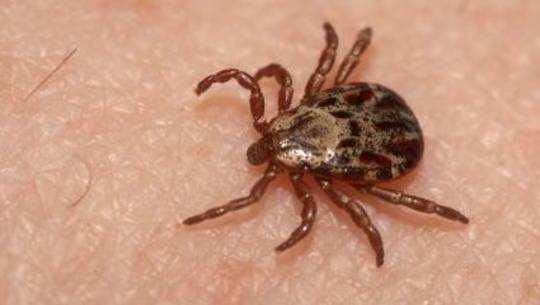
Bonus: 5.) Poppy-fern
[red opium poppy + fern]
“They were about the size of his forearm, firecracker-red, and tipped with black dots. From Aang's description, they had to be poppy-ferns.”
This is perhaps one of the most valuable plants in the world of ATLA. It is much-coveted by all four nations due to its pain-numbing properties. Poppy-ferns grow at the base of the Western Air Temple and at high-altitude areas within the Earth Kingdom. The mountainous town of Gaoling is known for the processing of poppy-ferns, and much of the Beifong’s wealth is built on poppy-fern export. Seep in water for mild pain-relief, or harvest the seeds to make a strong drug known as Opium.
Fun fact: the Southern Water Tribe’s treaty with the Earth Kingdom includes a clause about harvested poppy-ferns, as they’re often used to treat burn pains.

+

Other combos I’m currently fleshing out are shelled barracudas, cocoa-nuts, and cicada-keets! If these animal combos have any resemblance to pre-existing creations, I apologize! Each one of these was created independently by me, but it’s possible someone else has come up with the same idea.
58 notes
·
View notes
Photo

New Post has been published on http://www.lifehacker.guru/seven-budget-friendly-things-to-do-in-san-juan-puerto-rico/
Seven Budget-Friendly Things to do in San Juan, Puerto Rico
There’s a reason Puerto Rico is known as the “enchanted island”. It offers peaceful beaches, a tropical rainforest, unique nature, diverse culture, and fascinating architecture. Traveling there sounds expensive, and so does tourism, but I recently took a trip to San Juan, Puerto Rico, and I can tell you that it doesn’t have to be expensive. I can also tell you that there might be a lot of confusion, but hopefully my recent experience can clarify some of it. If you’re trying to narrow down your list of things to do, let me help you out by sharing seven things I did that weren’t just totally awesome—they were also budget-friendly. (Yes, this includes free things!)
1. Las Cabezas Nature Reserve Tour
In Fajardo, about an hour’s drive from San Juan, Las Cabezas nature reserve offers multiple tours. Don’t worry, they tell you which ones are okay for kids and which ones require some experience; they also have the option to take the tour in English or in Spanish. When I was there I went on two separate tours, the first of which was the reserve and lighthouse tour. This tour is $12 per adult, and gets you a trolley ride through the reserve to three special locations. Our first stop was the mangrove swamp boardwalk. Our guide led us through the mangroves explaining the ecosystem, wildlife, and other facts about the reserve as we wound around back to the trolley. Our second stop was Rocky Beach, a mesmerizingly beautiful beach only accessible via the reserve, whose shore is strewn with various rocks, chunks of coral, seashells, and even dried seaweed, some of which were small and some of which were very large.
Finally, our last stop was the Fajardo lighthouse. It’s the oldest lighthouse in Puerto Rico, and you can only visit it if you’re on a Las Cabezas tour. It’s a white building with bright green shutters, and the tower itself isn’t actually that tall since it sits so high above sea level. Parts of the building are museum-like, and here we learned more about what the reservation does, as well as a little bit about bioluminescence. For that part we were taken into a room with all the lights turned off, and our guide took out special bags from a container that contained some bioluminescent organisms. When she shook the bag, it glowed a bright blue, almost like specks of glitter, and was really cool to see! We also spent some time checking out the view from the lighthouse deck before being driven back to the main entrance. The most common wildlife you’re likely to see will be different birds, and of course iguanas.
Side note: The only way to see the reserve is through their tours, and you have to make a reservation. The gates don’t open until a half hour before each tour, and it is recommended that you arrive a half hour early. You can reserve spots by phone or through their website.
2. Laguna Grande Bioluminescent Bay Tour
Also in Fajardo, Laguna Grande is one of three bioluminescent bays in Puerto Rico. (There are not a lot of places you can find this anymore.) You can see this through a kayaking tour. However the tour I went on was also through Las Cabezas nature reserve. This tour is a little more expensive at $24 per adult, but it’s also really, really cool (and cheaper than kayaking). This tour worked out perfectly for us because one of the keys to having a good bioluminescent viewing experience is darkness, and we were there during the new moon so there was no moonlight interference. On this tour there are two stops. This time we went to the lighthouse first. Back on the lighthouse deck, we took in incredible views of the night sky—completely unobstructed views of the stars save for a few clouds. Then we went back downstairs for a presentation about bioluminescence and light pollution. (I could share some totally awesome facts with you, but for now I’ll highly recommend that you spend some time researching these things.) I’m from Chicago, so on a map of the U.S. that showed light pollution levels, it was interesting to see that Chicago is one of the biggest light pollution sources in the country.
After this presentation, we headed back to the mangrove swamp, but instead of winding around it, we were taken down the boardwalk that veered off toward the lagoon. Along the way, we stopped to pick up some long plastic poles, then continued walking. When we reached the end of the boardwalk, we faced the lagoon and used the poles to stir the water around us. The darker the area, the more bioluminescence we saw. Sadly, I could not capture any of this on camera, but I can tell you that a soft white glow trailed the poles when we moved them. The theory is that these organisms glow in defense, so the water lights up when it is disturbed. Another interesting thing to see was that even though we were about an hour from San Juan, we could still see the light coming from the city in the distance. Overall, this tour was totally worth it.
3. El Yunque
Only a 40-minute drive from San Juan, El Yunque National Rainforest was my favorite part of the trip, and to top it off, it’s absolutely free! If you want to stop at the visitors center and watch a movie about the rainforest, it costs $4, but my family and I opted to skip that. Just keep on driving up the road until you reach Cascada La Coca, El Yunque’s first waterfall. You can climb on the rocks here, but be careful. There’s a clear sign and parking by every site and trail, so you can get out of your car to enjoy the view and take pictures. Keep in mind that there are thirteen trails, so you can’t do it all in one day. After La Coca, we drove until we reached the first tower. Here we used the restrooms, and at the top of the tower we took in the expansive views of mountains and forest. Needless to say, it was picture perfect. (See above: The article image of the rainforest with the orange flowers is a picture I took from the top of the tower!) We decided that we only had time to do one of the trails, and chose to hike Big Tree Trail to Cascada La Mina, El Yunque’s most popular waterfall. As mentioned, there’s parking near the start of each trail; Big Tree itself goes on farther than the falls, but getting to La Mina takes about a half hour, and it’s awesome! The path is clear, laid out in stone, and not slippery. (Trust me, it will likely rain while you’re in the rainforest, so bring a raincoat.) It winds up and down, and curves slightly and sharply.
There’s nothing in Puerto Rico that’s poisonous or that will chase you. In fact, I hardly saw any wild life except stray cats. What you will see are trees bigger than any tree you’ve seen in your life, and colorful flowers and other tropical plants. (Fun fact: Because they’re about the size of your thumbnail, some of the wildlife you won’t see are the coquí frogs, native to Puerto Rico—but you will hear them, even in the city. They make a very loud, high-pitched noise that sounds sort of like a whistle, or even a cricket. That’s what gives them their name. It sounds like they are saying, “Coqui! Coqui!”) You hear the falls before you see them, and then they come into view. There’s a bridge going over the rocks that continues the path, but there are also some stairs that go down to the falls, because this one has a bit of a pool before all the rocks, and you can swim in it! Again, be careful because these rocks are super slippery. After chilling there for a little bit, we went back the way we came. At the end there was a guy selling really good, fresh lemonade in the parking lot, and that was extra refreshing. In a nutshell, I could go on about El Yunque for a while!
4. Old San Juan
There’s so much to see here. It’s easy to navigate and walk around, and the different-colored buildings and architecture are endlessly unique and fascinating. Just taking a walk around and visiting different shops and cafes is well worth your time, and as a bonus there are trolleys that take you around town for free! Just in case you’re interested in some more free tourism, there are some popular sights in downtown Old San Juan you can explore free of charge.
Plaza de Armas One of the main hubs of Old San Juan, this plaza has a beautiful fountain, lots of benches to chill on, and pigeons that will fearlessly walk around your feet. A lot of popular cafes and shops are within a block or two of this plaza.
Catedral de San Juan Bautista Only a couple blocks from the Plaza de Armas, this historical cathedral leaves its door open for people to wander through. The high ceilings are intricately painted, and there are a few open spaces on either side of the pews, most of which contain tidbits of history of San Juan Bautista and the cathedral itself. There is also beautifully colored stained glass and several ornate statues. It is recommended that you put a dollar in the donation box if you visit.
San Juan Gate This is also only a few blocks from the Plaza de Armas, just down the street from the Cathedral of San Juan. The gate isn’t an actual gate; you go through a big doorway (to clarify, this is outdoors), and then on either side is a blacktop walkway along the stone wall that goes up and down that side of the town. It’s right along the ocean, so if you’re looking for something chill to do, take a walk along the San Juan Gate and take in the ocean view and the architecture.
Colón Plaza This plaza is down the street from either entrance to the Castillo San Cristóbal; it’s smaller than the Plaza de Armas, but it has a large statue and fountain, and is surrounded by many popular shops and places to eat. At the time I was in this plaza, there were artisans set up in the square and some of the side streets due to the fact that the cruise ships were docked.
Side note: Since there aren’t trolleys through the rest of San Juan, I recommend taking a bus instead of a taxi. It costs 75 cents a person and the bus station is on the same street as trolley stops 1 and 2.
5. Local beaches
Going to the beach is free. There are a couple of public beaches in San Juan: Condado and Isla Verde. I never got to Isla Verde, but I spent a lovely afternoon relaxing on the sandy shores of Condado watching rolling crystal waves and wading in the water. If you go to the beach, especially more than once, bring a towel or a folding chair from the local Walmart to sit on because any recliners that are there probably belong to a hotel and they’ll charge you to use them.
6. Castillo San Cristóbal and El Morro
Located in Old San Juan, these National Historic Sites come two-for-one. By that I mean you get admission to both for $5. (Fun fact: These sites, along with El Yunque, are run by the U.S. Park Service.) I recommend going to San Cristóbal first. You can watch a short historical video before heading out to explore the fort. Give yourself plenty of time because it is huge. There are multiple levels. You can explore underground tunnels, the main courtyard, soldiers quarters, the gunpowder magazine, guard towers (very photogenic), an expansive battlefield, etc. I love history so I especially enjoyed this, but the architecture is also unique and very similar to that of its sister fort, El Morro. El Morro is about a 15-minute walk away if you’re up for walking, and to be admitted you just show your receipt from San Cristóbal. (Obviously, this would be vice versa if you go to El Morro first.) It is the older of the two forts, and holds Puerto Rico’s oldest lighthouse. (It burned down at some point and was rebuilt, which is why I said the Fajardo lighthouse is technically the oldest.) El Morro is also significantly smaller but no less magnificent. It’s easier to explore, and though you can’t go into the lighthouse, the outside is gorgeous. Visiting these forts should be at the top of your list.
7. Bacardí Distillery tour
Side note (especially for parents): The legal drinking age in Puerto Rico is eighteen.
Sadly this tour is no longer free, but is definitely still worth doing. They offer three different tours, all of which come with a complimentary glass and a token for a free drink, which you can enjoy on their outdoor pavilion before or after the tour. The cheapest tour—the Historical Tour—is $15 a person. The other two tours—the Mixology and Rum Tasting tours—are both $45 a person, but I highly recommend splurging. The tour that I went on was the Mixology tour. Our guide took us to each building on a trolley, and our first stop was the visitor center museum. We watched a short video, and then our guide explained more of the history and special facts about each of the rums, including what each is best mixed with. In the distillery, he explained the process of making rum. (Fun fact: Bacardí reuses barrels from Jack Daniels to minimize waste.)
In the last building, we were taken to a room set up with all the supplies we’d need to make our own drinks (and yes, you get to drink them). You get to make three drinks on this tour: a rum and coke with lime, a mojito with mint leaves, and a daiquiri. I won’t give away the recipes; however, I can tell you a trade secret: Always use fresh ingredients such as mint leaves, or slices of lime instead of lime juice. You should finish drinking the rum and coke by the time you’re done making the mojito, and you should finish drinking the mojito by the time you’re done making the daiquiri in your complimentary glass. The daiquiri you can take with you as you browse the gift shop and/or relax at the pavilion—and don’t forget you’ve got a free drink token. Last but not least, you get a personalized certificate in mixology! For $45 you get a tour, four drinks, you get to keep a glass, and you’re declared an official Bacardí mixologist! It was the most expensive thing we did the whole trip, and it was totally worth it.
Well, that’s all the room I’ve got to share for now, so I’ll just say that overall, Puerto Rico is a very unique place to visit, and I hope I’ll get to go again someday. It may be a small island, but there’s so much of it I haven’t seen. If you’re looking to go somewhere a little off the beaten path, somewhere easy to get to (I say this because you don’t need a passport to go there), or somewhere budget-friendly, it’s a place I highly recommend visiting. I don’t doubt you’ll come back with as many interesting stories to tell as I have.
©
0 notes